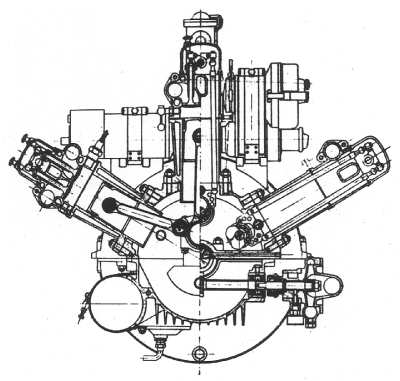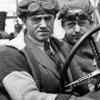
Benz Tropfenwagen
#1

Posted 11 March 2001 - 18:11
Advertisement
#2

Posted 11 March 2001 - 18:52
#3

Posted 11 March 2001 - 19:11
Welcome Chris!
[oops, Karl beat me!]
#4

Posted 11 March 2001 - 19:12
http://www.wopr.handshake.de/benz.jpg
http://home.earthlin...erodynamics.htm
#5

Posted 12 March 2001 - 02:19
There are a series of three pictures on this model (along with some information), I've scanned two of them in and will send to you if you would like. The other is similar to the ones that have already been provided in the two links above. Please send a PM with your address if you are interested. Don't think I should post them for copyright reasons.
Ursula
#6

Posted 12 March 2001 - 15:23
#7

Posted 26 December 2010 - 19:28
Sorry to re-open a long dormant thread, but have been reading in David Paine's excellent book 'The Zborowski Inheritance' where he refers to the gripping events of the 1923 Italian Grand Prix, one of the first run at the recently built Monza circuit. Minoia and Horner were driving Benz Tropfenwagens (hence I guess the reference to them in this thread!!)Just for the sake of accuracy, neither Minoia nor Hörner finished the race, they were both flagged off after completing 76 and 71 laps, respectively...
It appears that the reason they were 'flagged off' seems to be because, in typically hot headed Italian fashion, the crowd invaded the track soon after Salamano and Nazzarro of the victorious FIAT team had finished 1 and 2 and as 3rd placed driver Jimmy Murphy driving a Miller crossed the line. Minoia was classified as having come 4th, completing 76 laps but Horner was not classified with 71 laps only. Also flagged off was Alzaga in the second Miller (Zborowski's Miller having retired after 15 laps with a broken conrod caused by oil pump failure), a bit of a disappointment after racing for over 5 1/2 hours... Makes today's F1 events look like short circuit jobs!
Marticelli
Edited by Marticelli, 26 December 2010 - 23:11.
#9

Posted 27 December 2010 - 09:31
Dr Rumpler in fact designed his own a rear-engined Tropfenwagen road car which was shown at the 1921 Berlin Motor Show, and which he put into production in his own name.
The concept was licensed to Benz, who incorporated it in their GP car design
#10

Posted 27 December 2010 - 10:05
I thought that Benz negotiated, but decided not to proceed with, a license to use Rumpler's designs. This followed problems encountered in tests with a Rumpler prototype.The origins of the car as outlined in that article are wide of the mark
Dr Rumpler in fact designed his own a rear-engined Tropfenwagen road car which was shown at the 1921 Berlin Motor Show, and which he put into production in his own name.
The concept was licensed to Benz, who incorporated it in their GP car design
#11

Posted 27 December 2010 - 12:31
My point was that Dr Rumpler didn't design the GP Benz - or are you saying he did?
#12

Posted 27 December 2010 - 13:15
Sorry. i thought your point was that the concept was licensed to Benz who incorporated it into their GP car design.That could be true (though it conflicts with what I've read)
My point was that Dr Rumpler didn't design the GP Benz - or are you saying he did?
I didn't intend to imply that Rumpler designed the Benz although Georgano's Encyclopaedia of Motor Sport says that he did. My information on this comes from Karl Ludvigsen's Mercedes-Benz Racing Cars and Quicksilver Century which I tend to regard as definitive in these matters.
#13

Posted 27 December 2010 - 14:25

#14

Posted 27 December 2010 - 20:57
What is a fan-six engine?
#15

Posted 27 December 2010 - 22:57
#16

Posted 27 December 2010 - 23:32
I assume he's not your unreliable source.
#17

Posted 28 December 2010 - 00:15
#18

Posted 28 December 2010 - 00:52
The frame side rails of the Benz were shallow lightened members as it was a racing car whereas its Rumpler predecessors being big touring cars had much more metal there. You can see some of the frame in that photo I posted. The rear suspension, which I illustrated, shows the swing axle/splayed cantilever sprung rear end of the Benz and I think Rumpler was to blame for that - in conjunction with a beam front axle it must have handled as badly as possible.
#19

Posted 28 December 2010 - 02:13
My records show that Rumpler and Benz DID sign a deal to build a few of the Tropfenwagen passenger cars. A Benz engine was used, the fenders changed and it was converted to front-wheel drive. Only 100 were built and some used as taxis in Berlin. The rest were sold as movie props and some can be seen in Fritz Langs classic bit of cinema "Metropolis".
It was Willy Walb and Ferdinand Porsche who convinced Benz to retain the design for use on a GP car, which the board approved as the "Tropfenwagen Typ RH (RH = Rennwagen mitt Heckmotor)". I show Hans Neibel as well as Max Wagner having a large part in design and development. The only mention of engine design is of a 2 litre 6 cyl. 4 valves per cylinder, dual overhead cams and two Zenith carbs. I also show it used Rumpler's "swingarm" suspention design. It did have hillclimb wins with Walb and Adolf Rosenburger driving, but was deemed uncompetative and the project was shelved in 1926.
If any of this is incorrect, I'd like to know.
Edited by REDARMYSOJA, 28 December 2010 - 02:14.
Advertisement
#20

Posted 28 December 2010 - 07:43
And I hasten to add that it wasn't Mr Ludwigsen I was decrying, but someone whose name begins with a 'w' and ends in 'pedia'
#21

Posted 28 December 2010 - 08:29
If you scroll to the bottom of http://www.bungartz.nl/siemauto_d.html you will find a cross sectional drawing of the Rumpler engine (supposedly 2560cc) which looks like a wide angle V6 with parallel OHV to me, not a fan or W configuration like a Napier Lion.A usually unreliable source says the Rumpler had a W6 engine
Has anyone anything further about the track invasion at Monza in 1923 which seemingly ended the race prematurely for those not in the first four places? Interestingly this race was also apparently the first ever 'GP of Europe' as well as the Italian GP, again a little point that might be worthy of some elucidation.
Marticelli
#22

Posted 28 December 2010 - 08:40
If you scroll to the bottom of http://www.bungartz.nl/siemauto_d.html you will find a cross sectional drawing of the Rumpler engine (supposedly 2560cc) which looks like a wide angle V6 with parallel OHV to me, not a fan or W configuration like a Napier Lion.
I see a vertical cylinder (in half section) and (half) a conrod which is straight up.
#23

Posted 28 December 2010 - 08:43
Look again Martin: There is a clearly shown vertical bank of cylinders with detailed valvegear.If you scroll to the bottom of http://www.bungartz.nl/siemauto_d.html you will find a cross sectional drawing of the Rumpler engine (supposedly 2560cc) which looks like a wide angle V6 with parallel OHV to me, not a fan or W configuration like a Napier Lion.
Marticelli

Edited by Allan Lupton, 28 December 2010 - 08:44.
#24

Posted 28 December 2010 - 09:24
Karl Ludvigsen: "Edmund Rumpler and his patent lawyers caused Max Wagner some sleepless nights. Not having a Rumpler license agreement, Benz had to use a rear suspension design that wouldn't contravene Rumpler's many patents. As a result the RH had a much more practical system. Its conventional differential was fixed on the frame. It drove the axle half-shafts through universal joints in spherical housings similar to those then widely used for the forward mounting of torque-tube axles."The frame side rails of the Benz were shallow lightened members as it was a racing car whereas its Rumpler predecessors being big touring cars had much more metal there. You can see some of the frame in that photo I posted. The rear suspension, which I illustrated, shows the swing axle/splayed cantilever sprung rear end of the Benz and I think Rumpler was to blame for that - in conjunction with a beam front axle it must have handled as badly as possible.
#25

Posted 28 December 2010 - 09:29
Front-wheel drive?I'll add my two cents, and that's about all it's worth.
My records show that Rumpler and Benz DID sign a deal to build a few of the Tropfenwagen passenger cars. A Benz engine was used, the fenders changed and it was converted to front-wheel drive. Only 100 were built and some used as taxis in Berlin. The rest were sold as movie props and some can be seen in Fritz Langs classic bit of cinema "Metropolis".
It was Willy Walb and Ferdinand Porsche who convinced Benz to retain the design for use on a GP car, which the board approved as the "Tropfenwagen Typ RH (RH = Rennwagen mitt Heckmotor)". I show Hans Neibel as well as Max Wagner having a large part in design and development. The only mention of engine design is of a 2 litre 6 cyl. 4 valves per cylinder, dual overhead cams and two Zenith carbs. I also show it used Rumpler's "swingarm" suspention design. It did have hillclimb wins with Walb and Adolf Rosenburger driving, but was deemed uncompetative and the project was shelved in 1926.
If any of this is incorrect, I'd like to know.
I also think it unlikely that Ferdinand Porsche had any influence on Benz's decision to retain the rear-engined GP design. He joined DMG in 1923 and was working on the eight-cylinder Mercedes GP car in competition to the Benz. It is more likely that he influenced the cancellation of the Benz project when the two companies began to collaborate.
#26

Posted 28 December 2010 - 09:56
I'm sure KL will defend his position if necessary, but the rear transmission/suspension arrangements of the Rumpler Tropfenwagen and the Benz look pretty similar to me.Karl Ludvigsen: "Edmund Rumpler and his patent lawyers caused Max Wagner some sleepless nights. Not having a Rumpler license agreement, Benz had to use a rear suspension design that wouldn't contravene Rumpler's many patents. As a result the RH had a much more practical system. Its conventional differential was fixed on the frame. It drove the axle half-shafts through universal joints in spherical housings similar to those then widely used for the forward mounting of torque-tube axles."
Here is the Rumpler (detail obscured by body of course):

and here is the Benz:

Edited by Allan Lupton, 28 December 2010 - 09:57.
#27

Posted 28 December 2010 - 10:01
The track invasion is mentioned briefly in the report in the Swiss Automobil Revue, but in no more detail than you already know.Has anyone anything further about the track invasion at Monza in 1923 which seemingly ended the race prematurely for those not in the first four places? Interestingly this race was also apparently the first ever 'GP of Europe' as well as the Italian GP, again a little point that might be worthy of some elucidation.
Marticelli
We have had a thread about the GP d'Europe, but it's not all that informative:
http://forums.autosp...w...1&hl=Europe
#28

Posted 28 December 2010 - 19:24
Front-wheel drive?
I also think it unlikely that Ferdinand Porsche had any influence on Benz's decision to retain the rear-engined GP design. He joined DMG in 1923 and was working on the eight-cylinder Mercedes GP car in competition to the Benz. It is more likely that he influenced the cancellation of the Benz project when the two companies began to collaborate.
My information comes from Mattijs Diepraam over at 8W.
Rumpler entered into a licensing deal with Benz in 1925 to place Benz’s 2.6-litre 50hp engine in the back, and converted back to traditional fenders too to create the Typ 4A 106 follow-up, even switching to front-wheel drive as a last resort, but it was too little (or perhaps too much) too late. The remaining Tropfenwagen, of which only a hundred were built, were sold off cheaply to Berlin taxi drivers while the rest of them were ritually burned to the ground at the end of Fritz Lang’s famous masterpiece Metropolis, having been sold at bare value to movie company UFA.
Benz RH
That was long after Rumpler’s first dealings with Benz & Cie of Mannheim, which was all over Rumpler’s design soon after its first appearance in 1921. This was largely due to the vision of Benz’s Berlin representative, Willy Walb – and if anyone jumps up at the name they are right. Walb was to become the first Rennleiter of Auto Union’s famous racing department of the thirties, where he linked up once again with Dr Ferdinand Porsche and was the first to test-drive Porsche’s prototype. Both were involved in the creation of the Benz Tropfenwagen as well. It was the great German marque’s take on Rumpler’s original design, having licensed it as early as 1922 with an eye on using it for competition purposes. Its hoped-for race wins on Sunday could then act as a front for more sales on Monday, since Benz's image was starting to lack a certain pizazz.
http://forix.autospo...nes-prewar.html
A usually reliable source.
#29

Posted 29 December 2010 - 09:02
I have not seen this before, but it's a bit too Wikipedia-like for me with a lot of speculation presented as fact. (e.g. the implication that Dr. Porsche, who was with Daimler at Stuttgart 1923-29, was in some way involved with the Benz RH which was ready for Monza in 1923, the year before Benz and Daimler started working together.)My information comes from Mattijs Diepraam over at 8W.
http://forix.autospo...nes-prewar.html
A usually reliable source.
Maybe it lost something in translation.
Edited by Allan Lupton, 29 December 2010 - 09:17.
#30

Posted 29 December 2010 - 10:09
THe reference to front-wheel drive appears to be that Rumpler built such a car using a Benz engine.
#31

Posted 29 December 2010 - 20:07
I have not seen this before, but it's a bit too Wikipedia-like for me with a lot of speculation presented as fact. (e.g. the implication that Dr. Porsche, who was with Daimler at Stuttgart 1923-29, was in some way involved with the Benz RH which was ready for Monza in 1923, the year before Benz and Daimler started working together.)
Maybe it lost something in translation.
I assure you Mattijs Diepraam did thorough research.
I think I see the problem. I did say Walb and Porsche worked together to convince Benz to retain the design for use in a GP car, but I believe that is where I went wrong. Looking at Mattijs Diepraam's story more closely, it seems clear he is saying Porsche was involved only after Rumpler entered into the agreement with Benz in 1925, well after Daimler and Benz entered into their agreement in May of 1924. It also seems clear Dr. Porsche's only involvment was with the road car version which was unsucessful.
Both were involved in the creation of the Benz Tropfenwagen as well. It was the great German marque’s take on Rumpler’s original design
I think it's clear by that he is refering to the Tropfenwagen road car only.
#32

Posted 17 April 2023 - 20:10
A super enigma and ripe for recreation?!


















